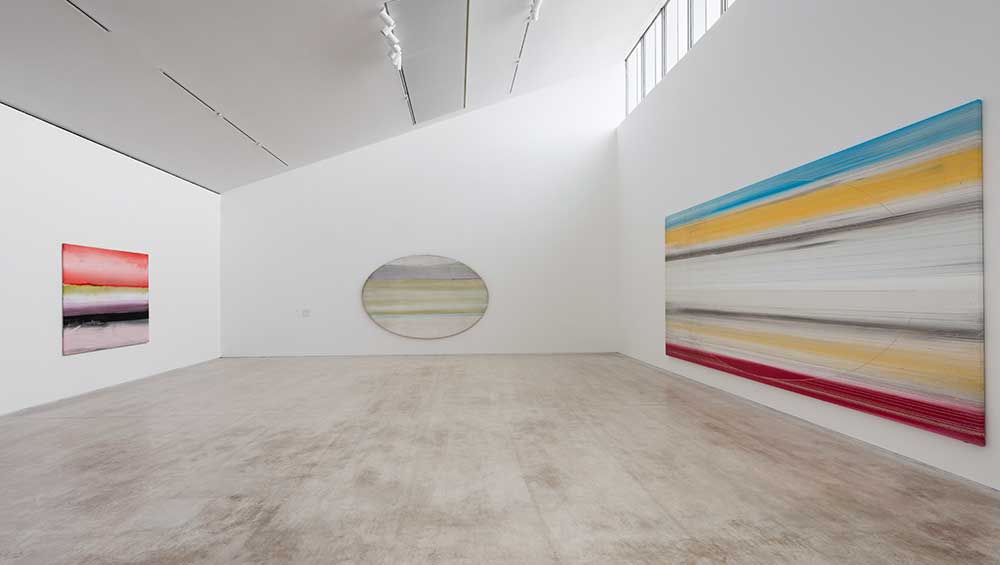
Ed Clark, 2024. Installation view. © Courtesy Turner Contemporary. Photo: Thierry Bal.
Turner Contemporary, Margate
25 May – 1 September 2024
by DAVID TRIGG
The last room of this elegant exhibition contains a film in which Ed Clark (1926-2019) is hard at work, using a 1.2 metre (48in) push broom as a paintbrush to drag paint around a canvas on his studio floor. It is a messy, chaotic and seemingly haphazard affair. Yet, the abstract canvases and works on paper that fill the preceding four rooms display a structured orderliness that belie the American painter’s unconventional technique, which he called “the big sweep”. Although Clark was a groundbreaking figure among second-generation abstract expressionists within the New York school, this retrospective is surprisingly his first institutional exhibition in Europe. Bringing together works from the 1940s to the 2000s, many of which have not been seen outside the United States, it provides a welcome opportunity for British audiences to get to know this overlooked figure.
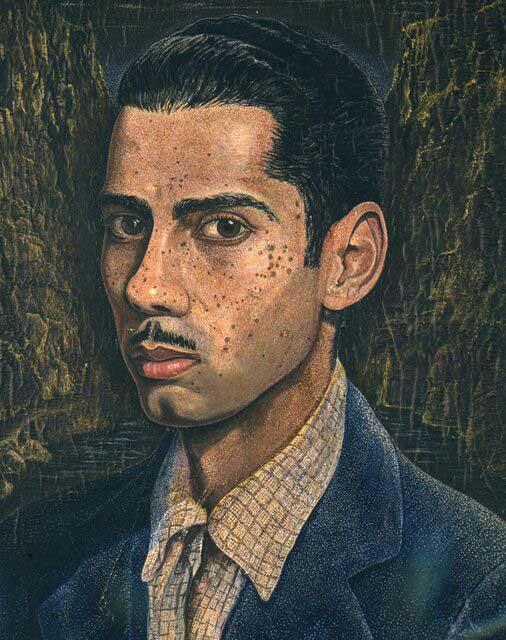
Ed Clark, Self Portrait, 1947-49. © The Estate of Ed Clark. Courtesy the Estate and Hauser & Wirth.
Clark invented “the big sweep” in 1956, while living in Paris. Like many African American creatives – including Beauford Delaney and James Baldwin – he embraced postwar France, finding new freedoms and inspirations while being supported by the GI Bill. He had arrived there four years earlier to study at the prestigious L’Académie de la Grande Chaumière, having already taken evening classes in the US at the conservative Art Institute of Chicago. The institute had given him a strong grounding in traditional, figurative technique, as evidenced by the striking Self-Portrait (1947-49) that opens the show, but Paris exposed him to new, modernist influences, from Paul Cézanne to contemporaries such as Nicolas de Staël and Jean-Paul Riopelle. Having mastered figuration, he now embraced abstraction.
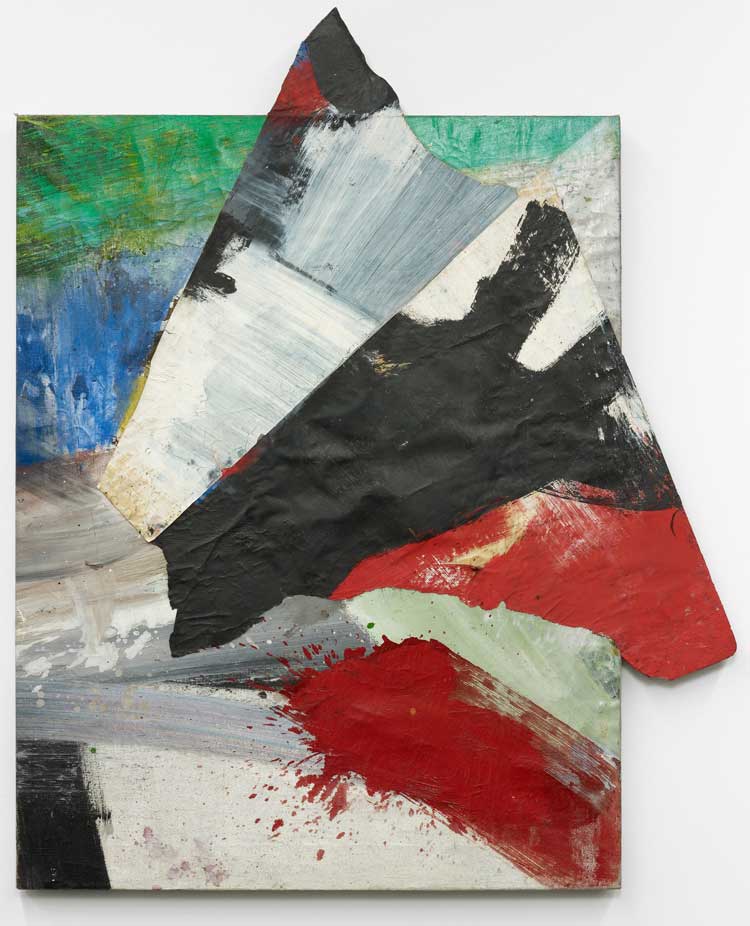
Ed Clark, Untitled. 1957. The Art Institute of Chicago. © The Art Institute of Chicago / Art Resource, NY. Photo: Elyse Allen.
Although his unusual choice of brush was later considered by some to be an ironic comment on menial labour and racial discrimination, Clark always maintained that his true subject was paint itself. Settling in New York in 1957, he continued to explore abstract form, pure colour and the materiality of paint, creating dynamic, large-scale abstractions. He also experimented with shaped canvases, such as Untitled (1957), in which bold red and black brushstrokes appear to burst out of the conventional rectangular frame.

Ed Clark, Locomotion, 1963. © The Estate of Ed Clark. Courtesy the Estate and Hauser & Wirth. Photo: Thomas Barratt.
Clark’s paintings of the 1960s are characterised by wide sweeps of intense, unmodulated colour. In Locomotion (1963), gestural brushstrokes in burning orange, Prussian blue and candyfloss pink meld with controlled passages of marine green and jet black. Splashes and splatters abound, introducing elements of randomness to the painting’s carefully organised verticals, horizontals and diagonals. These also speak to the pace at which Clark worked, using his broom to imbue his works with an energy that could not be achieved with conventional brushes. “It’s like cutting through something really fast,” he once said of his technique. “That’s what the straight stroke with the push broom gives you, speed.”
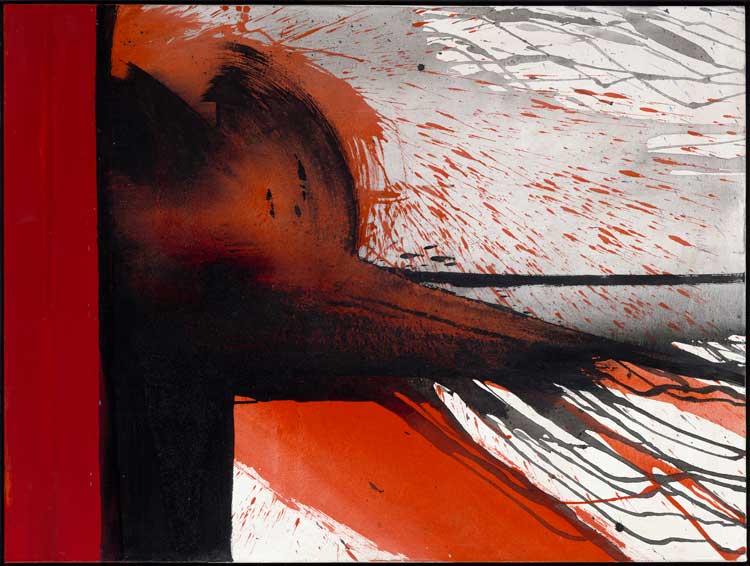
Ed Clark, Blacklash, 1964. © The Art Institute of Chicago / Art Resource, NY.
Clark was frequently ignored by the art establishment of the day, which tended to align abstraction with white artists. Yet despite being subject to discrimination, he refused to have his work interpreted through the lens of race and even turned down invitations to participate in exhibitions of African American art. A rare example of politics entering his work is found in Blacklash (1964), created in response to the murder of a 15-year-old African American boy, James Powell, by an off-duty police officer, and the rioting that ensued in Harlem. This angry commentary on oppression and social injustice features violent splatters of red, black and grey paint, balanced by bold vertical and horizontal brushstrokes.
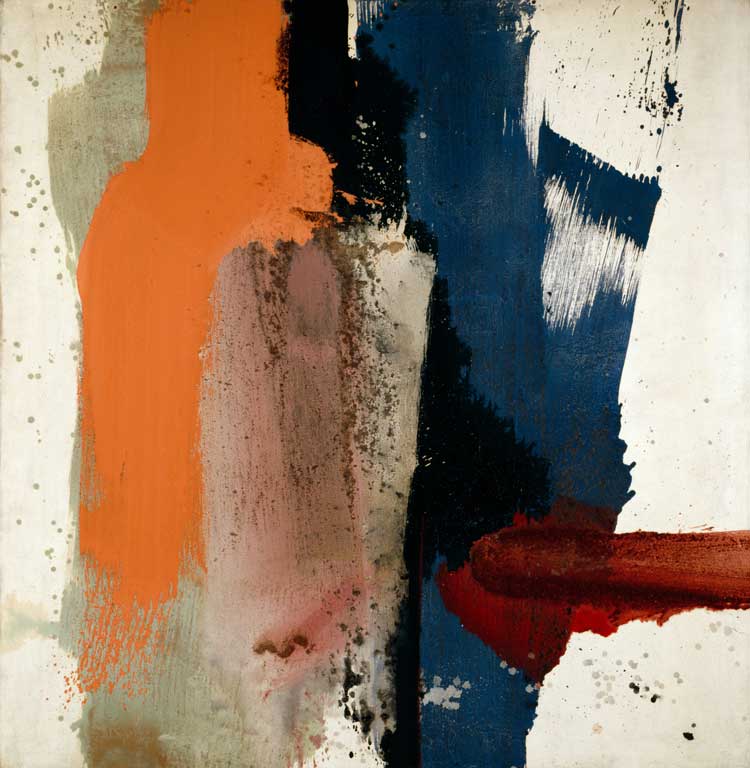
Ed Clark, Maple Red 1963. Detroit Institute of Arts. © The Estate of Ed Clark. Courtesy the Estate and Hauser & Wirth.
In the early 70s, Clark moved away from strong colours to a softer palette, characterised by pinks and blues. He also continued to experiment with shaped canvases. While staying with fellow American artist Joan Mitchell in northern France, he commissioned a local carpenter to make his first oval stretcher. “We do not see rectangles,” he once said, speaking about his move away from right-angles. “Our eyes are oval shaped. Why do we do rectangles?” Nevertheless, he continued to produce his fair share of rectangular canvases, often working on an ambitious scale to create paintings that envelop the viewer’s field of vision. A selection of these impressive works is included here, some of which incorporate ovals into carefully controlled compositions of subtly coloured horizontal bands. It is tempting to see sunsets, deserts and reflections, but while many of these works are certainly inspired by the light and atmosphere of the many countries he visited – among them, Nigeria, Mexico, Brazil, Egypt and China – Clark was never one for such literal interpretations.
Before the final room is a corridor of archival material featuring photographs, letters, exhibition pamphlets and sketchbook pages. These documents show how Clark was embedded in New York’s dynamic downtown scene and how he co-founded the Brata Gallery, an artist-run cooperative among the 10th Street galleries of the East Village. One exhibition booklet from 1994 includes several undated quotes from the few art magazines that covered his work. Art in America described him as “an artist who has made a career of unorthodoxy”, while Art News aptly proclaimed: “His work never seems insecure or lost, and recognition of its worth is long overdue.”
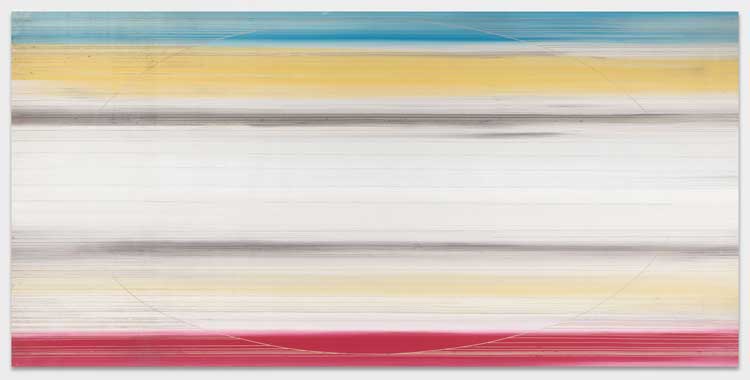
Ed Clark, Untitled c.1976. © The Estate of Ed Clark. Courtesy the Estate and Hauser & Wirth.
Following his first retrospective, A Complex Identity, at the Studio Museum in Harlem in 1980, Clark pushed his work in new directions. The oval forms fragmented, turning into arcs, curves and waves, while the unerring horizontals that had dominated earlier works became freer and less rigid. He also began pouring paint and pushing dry pigment across his canvases with a wet broom. The playful works from the 1980s to the 2000s which close the exhibition evidence a much looser approach to image-making, suggesting an artist completely at ease with his medium. Yet, as with all of Clark’s works, these compositions remain carefully balanced, displaying an internal structural logic.
This was a period in which Clark, quite rightly, was beginning to receive the recognition he deserved. In 1981, writing in Art News, the critic Cynthia Nadelman made a statement about Clark’s art that still resonates today: “[This is] work that makes a strong contribution to the language of abstract expressionism and post abstract expressionism. Where has Ed Clark been all our lives?”